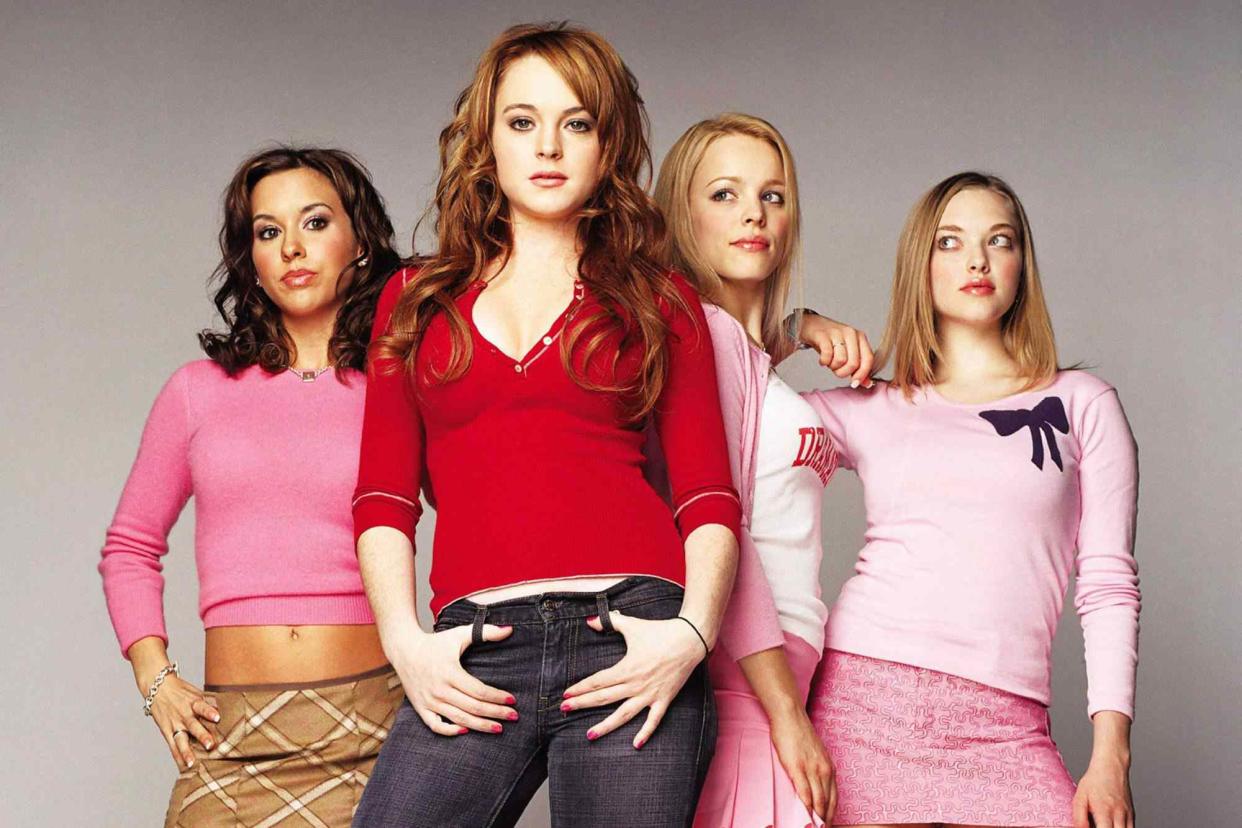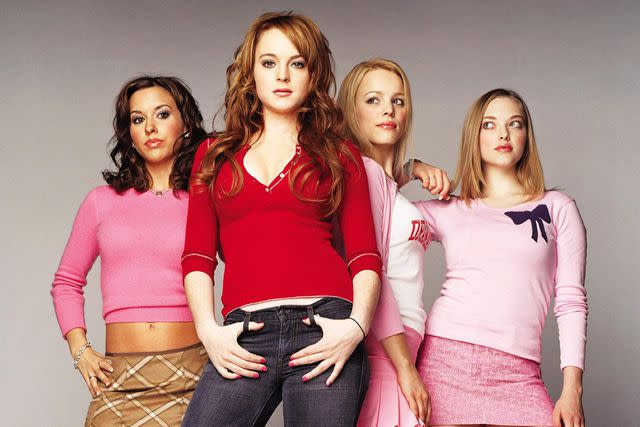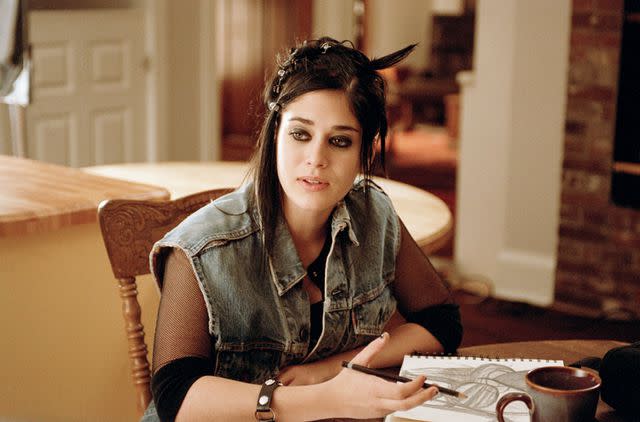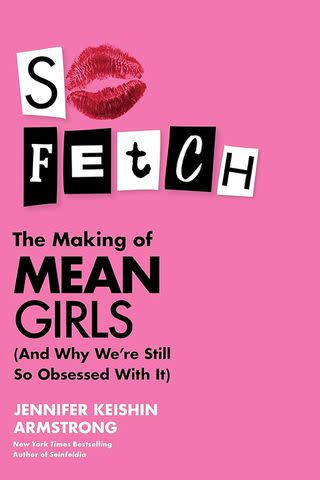Megan Fox as Karen? Vanessa Hudgens as Gretchen? Amanda Seyfried as Regina? New book “So Fetch” reveals casting secrets of “Mean Girls”

- Oops!Something went wrong.Please try again later.
- Oops!Something went wrong.Please try again later.
- Oops!Something went wrong.Please try again later.
- Oops!Something went wrong.Please try again later.
- Oops!Something went wrong.Please try again later.
- Oops!Something went wrong.Please try again later.
- Oops!Something went wrong.Please try again later.
- Oops!Something went wrong.Please try again later.
- Oops!Something went wrong.Please try again later.
Read an exclusive excerpt of "So Fetch: The Making of Mean Girls (And Why We’re Still So Obsessed with It)" by Jennifer Armstrong
The Mean Girls cast was almost an entirely different group of grool actresses.
In new book, So Fetch: The Making of Mean Girls (And Why We're Still So Obsessed With It), author Jennifer Armstrong takes readers behind the exhaustive casting process of the 2004 teen comedy. EW can share an exclusive excerpt from the book below.
The excerpt details director Mark Waters love for Rachel McAdams as an actress, but his sense that she read too old as Cady, the role for which she originally auditioned. Initially, they thought Amanda Seyfried was their Regina George, before ultimately circling back to McAdams in the role.

In the mix for Karen, the role that went to Seyfried in the end, were major early 2000s stars including Leighton Meester, Haylie Duff, Kate Mara, Blake Lively, and Megan Fox. Seyfried was poised to start school at Fordham University, but she missed her first class due to rushing there from her Mean Girls audition — she never did go back to college.
While Lacey Chabert, then best known for Party of Five, made Gretchen Weiners' line delivery the stuff of legend, there were originally many other actresses in the mix, including Ashley Tisdale, Vanessa Hudgens, and Mary Elizabeth Winstead.

Paramount/courtesy Everett
Lizzy Caplan in 'Mean Girls'Apart from the Plastics, there were also a lot of famous faces who were considered for the role of outsider Janis, played by Lizzy Caplan, who had to radically alter her appearance to sell Janis' Goth Girl vibes. But Ugly Betty star America Ferrera and Two Broke Girls actress Kat Dennings were also both heavily favored for the role.
So Fetch is bursting with never-before-revealed stories and details from the making of Mean Girls and its enduring cultural impact. For more, read the excerpt below. So Fetch hits shelves on Jan. 16.

courtesy amazon
So Fetch: The Making of Mean GirlsExcerpt from "So Fetch" by Jennifer Armstrong
Liroff and Waters brought a handful of actresses in to test as Regina with Lohan as Cady, including McAdams. Waters knew McAdams would crush it, but something even more interesting happened when the two actresses came together. Not only did McAdams inhabit the lines perfectly, she also seemed to intimidate Lohan. She was older, she had gone to theater school, and she had recently finished shooting a weepy adult drama called The Notebook that wasn’t out yet but had everyone in town talking. She was verging on stardom, and it was emanating from her. This fascinated Waters. In his experience with Lohan so far, she usually dominated everyone, commanded a room. When she was with McAdams, that changed.
In the end it came down to two actresses who had tested for Regina: McAdams and the younger Amanda Seyfried, who was seventeen like Lohan. But Waters couldn’t resist the dynamic he’d witnessed between Lohan and McAdams.
When Sherry Lansing saw McAdams as Regina, she fell in love with the actress. She thought McAdams would make the perfect Queen Bee. She was “rivetingly beautiful,” Lansing remembers, and “such a good actress.”
One of Lansing’s executives protested that McAdams was too old. “Let me explain something,” Lansing said. This age discussion made her tense. At nearly sixty, it seemed absurd to her. “She doesn’t look twenty-five. So I don’t care how old she is. I don’t care.” But, the executive said, what if it got out that McAdams was older? “What difference does it make if it gets out?” Lansing said. “She’s perfect.”
Daniel Franzese, meanwhile, had killed at his audition... in the waiting area outside the room where casting for Mean Girls was happening. Franzese was there because the role of Damian remained vacant—and frustrating to fill—so writer Tina Fey and director Mark Waters were squeezing him in, hoping he’d be the one.
Franzese held court in the waiting area, where Seyfried, still in her teens and hoping to land her first movie, was about to audition a second time, screen-testing for Regina before they had decided for sure on McAdams. Fey and Waters joined Franzese and Seyfried to make idle chitchat as the casting folks set up the cameras inside the audition room. Seyfried asked Fey whether she should wear the ma- roon shirt that she’d brought along for her screen test or the tan one. Franzese, a wise and confident twenty-five, interjected: “I’d go with the merlot.”
Franzese chatted up Fey and Waters with ease for a good twenty minutes. Yeah, Waters thought, this guy’s great. He seemed like the answer to their Damian problem. They wanted someone naturally likable, snarky but not bitchy, a little awkward, a little vulnerable, and very fun. They didn’t want someone to play the Gay Kid. They wanted someone to play Damian.
When the room was ready, Seyfried went first and nailed it. Fey and Waters loved her, even though they’d ultimately cast McAdams as Regina. “She was freaky,” Waters says of Seyfried’s approach to Regina. “She did a whole different take on it. It was kind of like this weirdly spooky girl who just had strange thoughts. She had this inner life.” Producer Lorne Michaels actually preferred her for the role of Regina but was outvoted in the end.
Then Franzese came in to read and bombed. All of the personality they’d just seen in the waiting room had evaporated. Where had that funny, confident, easy-to-talk-to guy gone? Now he seemed to be just playing a character, but they’d liked the real guy better.
Damian had become a problem. Liroff had found one kid she loved named Cole Williams, with spiky blond hair, blue eyes, and a killer smile — Leonardo DiCaprio if he were in a 2000s boy band. (Williams was also a piece of Hollywood trivia, the son of songwriter Paul Williams, known for the Carpenters’ hits “We’ve Only Just Begun” and “Rainy Days and Mondays.”) But the others on the Mean Girls team weren’t on board with Williams.
The table read was coming up in Los Angeles, and they had to make a call. The filmmakers and executives debated among themselves and with outside confidants. Paramount executive John Goldwyn insisted, “He can’t feel like a club kid.” They didn’t want Damian to be too cool, which could have been a problem with Williams.
Fey was having trouble because she had such a clear idea of the character in her head. She told her friend Damian Holbrook, the inspiration for the character, that she’d met this guy she loved. He was sweet and Italian, perfect for the part. “That’s not exactly me,” Hol- brook said. He was neither sweet nor Italian, but he knew casting was all about gut feeling, not a literal match.
Franzese really wanted the role, which could have been what threw him off. He wouldn’t have been the first amiable actor to choke on nerves at the crucial moment. “This was the first time I ever read a gay character who was able to live through a whole school year without ever feeling like he was going to be hit on the back of the head,” he later said. “There was something about that which really spoke to me; it felt like it was really pushing the envelope.” Damian would be a dream role for him. Franzese was gay but not out, while this character owned his identity so confidently, and in high school, no less. Gay teen characters up until this point had been traditionally closeted, tragic, and bullied, if they showed up at all.
Franzese seemed like the obvious choice, except for that one tiny matter of bombing his audition. He also hadn’t read with any of the other actors to check for chemistry—most important, Lizzy Caplan, whom Waters had recently settled on as Damian’s best friend, Janis. Her role presented its own share of challenges. She’d have to sell audiences on the idea that her character was not supposed to be the vil- lain here, even though she did some pretty questionable things. Upon meeting Cady and being told her name is pronounced like “Katie,” Janis declares that she plans to call her “Caddy.” (This is, it must be said, a funny play on the word “catty.”) She introduces Damian as “al- most too gay to function,” which he seems to be okay with but is not an ideal way to present your best friend to someone new. She goes on to explain to Cady that Regina George is a “selfish, backstabbing, slut-faced ho-bag.” She drives the entire plot by using Cady as a pawn in a scheme to psychologically torture Regina.
But Caplan presented as sharp, smart, and sarcastic in her audition, someone to root for. She had a star quality that would make Janis likable no matter what she did. The filmmakers hesitated to cast Caplan for only one reason: she was so “uncommonly beautiful,” as Liroff describes her. With thick brown hair that contrasted with her light skin, and perfect bone structure, she looked like she could be a Plastic. Would anyone believe her as an outcast?
When Waters confronted her about this problem in the audition, she shrugged. “Look,” she said, “I’ll goth myself out.” She said it with such confidence that he believed her. The fact was, she knew how to inhabit this girl more than it may have seemed on the outside. She loved Charles Bukowski and had dyed her hair black in high school. She would happily dye it again and flat-iron it into wild spikes to get this job. He’d see for sure if it worked when she showed up for the table read. Some other genuinely appealing actresses had read for the part, including America Ferrera and Kat Dennings, but Caplan snagged it in the end.
Even with all of that mostly settled, Liroff still had huge parts to fill. She had yet to find the right combination for Regina’s two Plastics sidekicks, Gretchen and Karen.
The casting director felt like she had read every age-appropriate actress in town for Gretchen, Regina’s high-strung second-in-command, and still had not found the right girl, even as the table read approached. Further throwing the casting off, the script described her as “gangly.” Liroff had to abandon that particular idea quickly in hopes of getting the right actress. Ashley Tisdale, Vanessa Hudgens, and Mary Elizabeth Winstead tried out but still weren’t quite right. The character “has a specific timing in terms of comedy,” Liroff says. “And she’s this wannabe. It’s a fine line to play.”
Liroff didn’t know what she was going to do until Lacey Chabert walked into her office. Chabert didn’t think she was right for the part at all, given the physical description. Chabert had a petite, five-foot- two, hourglass figure. But she said of the character, “I loved how insecure she was. For me, the comedy came in her trying so desperately to please everyone and fit in and having no clue of her own identity.”
Born in Purvis, Mississippi, Chabert came to her Mean Girls audi- tion at age twenty with an already-packed résumé. She had appeared in the movies Lost in Space and Not Another Teen Movie, but she was best known as the youngest sister on the orphan drama Party of Five. Be- fore her Mean Girls audition, she had rarely displayed her comedy skill. Most of her work had leaned dramatic, especially given the melodrama of Party of Five. As Gretchen, she would deliver some of the movie’s best lines, as well as its most famous: “That is so fetch!” As Regina’s gossipmongering confidante, she’s key to the movie’s success.
She was a revelation in her Mean Girls tryout.
Liroff could immediately see that Chabert understood the complicated role and was a gifted comedic actress. The casting director tingled with excitement as she packed up the audition tape to send to Toronto, where Waters was prepping for production, and she was tortured by the three days it would take to get to him. Once he saw it, he immediately agreed. He had never considered anyone else seriously for the role, but Chabert was Gretchen.
They cast Chabert in late September 2003, with an October start date for the production looming. Liroff still needed to cast the role of Karen at that point. Leighton Meester, Haylie Duff, Kate Mara, Blake Lively, and Megan Fox had all auditioned, but none felt quite right. Lively was the most likely candidate at that point, but Liroff was moved to keep looking.
Waters kept returning to Seyfried, who had a quality he wanted on-screen. And Michaels, who had loved Seyfried’s tape, put the pieces together. As the filmmakers talked about Seyfried yet again, he said, “What about the dumb girl? Do you think she can play that?”
When they brought Seyfried back in to read for Karen, everything fell into place. That “spooky thing” Waters had seen her bring to Re- gina carried the character of Karen to a whole new level of hilarity. “Nobody else had kind of found that weird airy thing she had,” Waters says. “That was perfect.”
The filmmakers saw interesting potential in casting her as the dippy Karen Smith. It took a smart actor to play a character who claims to be able to forecast the weather with her breasts and who has to de- liver lines like “If you’re from Africa, why are you white?” As Liroff says, “You’d think when you cast a dumb blond that you should cast an actual dumb blond. And it doesn’t really work that way. You’re meant to find someone that is incredibly sharp so they can actually play that.” Seyfried would be joining a character lineage that stretched from Marilyn Monroe to Reese Witherspoon’s stereotype-upending take on the trope in 2001’s Legally Blonde, even channeling Monroe specifically to come up with Karen’s whispery voice.
Seyfried grew up in Allentown, Pennsylvania, where she’d just graduated from high school. She had modeled as a child, in a campaign for Limited Too and on young adult book covers. “You’ve got to picture a ten-year-old wanting to be Cindy Crawford,” she said of her modeling career. “I didn’t know what that meant. I just knew it seemed very glamorous and fun and people made you look nice and you got to wear pretty clothes.” She also did local theater, and because New York City was less than two hours away by bus, she started going to more professional auditions. She landed on the daytime soaps As the World Turns and All My Children. Her character on All My Children had been shipped off, and Seyfried had been fired, only weeks before she auditioned for Mean Girls.
She connected to the idea of Karen because she herself had often played dumb during her high school years, finding it an effective way to steer clear of exactly the kind of girl drama depicted in Mean Girls. (This brings up a tantalizing alternative read on Karen: Could she have been playing dumb the whole time on purpose?) Seyfried was planning to start college at Fordham University that fall, and even tried to go to one class, which she couldn’t find because she’d rushed straight there from her Mean Girls audition. She gave up after fifteen minutes and went home, then got the call offering her the role of Karen later that week. She put off higher education, never to return. She would land two major television roles, on Veronica Mars and Big Love, soon after Mean Girls, and her career grew from there. “My life turned in a day, an hour,” she later said.
Excerpted from the book SO FETCH: The Making of MEAN GIRLS (And Why We’re Still So Obsessed with It). Copyright © 2023 by Jennifer Armstrong. From Dey Street Books, an imprint of HarperCollins Publishers. Reprinted by permission.
Related content:
Making fetch happen: What to expect from the Mean Girls musical movie
Mean Girls musical movie cast remembers the first time they saw the original
Read the original article on Entertainment Weekly.

